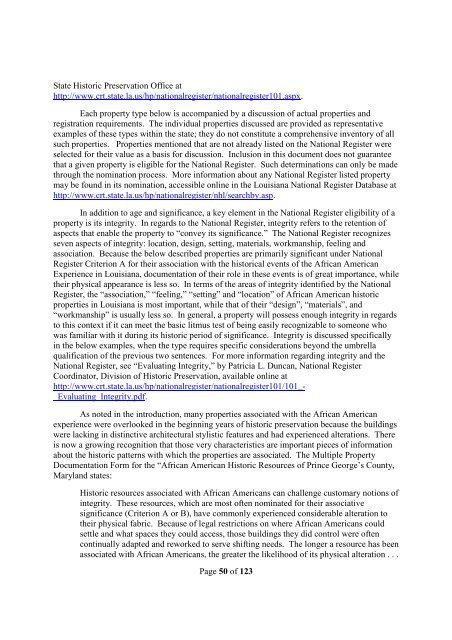The African American Experience in Louisiana
The_African_American_Experience_in_Louisiana
The_African_American_Experience_in_Louisiana
- No tags were found...
You also want an ePaper? Increase the reach of your titles
YUMPU automatically turns print PDFs into web optimized ePapers that Google loves.
State Historic Preservation Office at<br />
http://www.crt.state.la.us/hp/nationalregister/nationalregister101.aspx.<br />
Each property type below is accompanied by a discussion of actual properties and<br />
registration requirements. <strong>The</strong> <strong>in</strong>dividual properties discussed are provided as representative<br />
examples of these types with<strong>in</strong> the state; they do not constitute a comprehensive <strong>in</strong>ventory of all<br />
such properties. Properties mentioned that are not already listed on the National Register were<br />
selected for their value as a basis for discussion. Inclusion <strong>in</strong> this document does not guarantee<br />
that a given property is eligible for the National Register. Such determ<strong>in</strong>ations can only be made<br />
through the nom<strong>in</strong>ation process. More <strong>in</strong>formation about any National Register listed property<br />
may be found <strong>in</strong> its nom<strong>in</strong>ation, accessible onl<strong>in</strong>e <strong>in</strong> the <strong>Louisiana</strong> National Register Database at<br />
http://www.crt.state.la.us/hp/nationalregister/nhl/searchby.asp.<br />
In addition to age and significance, a key element <strong>in</strong> the National Register eligibility of a<br />
property is its <strong>in</strong>tegrity. In regards to the National Register, <strong>in</strong>tegrity refers to the retention of<br />
aspects that enable the property to “convey its significance.” <strong>The</strong> National Register recognizes<br />
seven aspects of <strong>in</strong>tegrity: location, design, sett<strong>in</strong>g, materials, workmanship, feel<strong>in</strong>g and<br />
association. Because the below described properties are primarily significant under National<br />
Register Criterion A for their association with the historical events of the <strong>African</strong> <strong>American</strong><br />
<strong>Experience</strong> <strong>in</strong> <strong>Louisiana</strong>, documentation of their role <strong>in</strong> these events is of great importance, while<br />
their physical appearance is less so. In terms of the areas of <strong>in</strong>tegrity identified by the National<br />
Register, the “association,” “feel<strong>in</strong>g,” “sett<strong>in</strong>g” and “location” of <strong>African</strong> <strong>American</strong> historic<br />
properties <strong>in</strong> <strong>Louisiana</strong> is most important, while that of their “design”, “materials”, and<br />
“workmanship” is usually less so. In general, a property will possess enough <strong>in</strong>tegrity <strong>in</strong> regards<br />
to this context if it can meet the basic litmus test of be<strong>in</strong>g easily recognizable to someone who<br />
was familiar with it dur<strong>in</strong>g its historic period of significance. Integrity is discussed specifically<br />
<strong>in</strong> the below examples, when the type requires specific considerations beyond the umbrella<br />
qualification of the previous two sentences. For more <strong>in</strong>formation regard<strong>in</strong>g <strong>in</strong>tegrity and the<br />
National Register, see “Evaluat<strong>in</strong>g Integrity,” by Patricia L. Duncan, National Register<br />
Coord<strong>in</strong>ator, Division of Historic Preservation, available onl<strong>in</strong>e at<br />
http://www.crt.state.la.us/hp/nationalregister/nationalregister101/101_-<br />
_Evaluat<strong>in</strong>g_Integrity.pdf.<br />
As noted <strong>in</strong> the <strong>in</strong>troduction, many properties associated with the <strong>African</strong> <strong>American</strong><br />
experience were overlooked <strong>in</strong> the beg<strong>in</strong>n<strong>in</strong>g years of historic preservation because the build<strong>in</strong>gs<br />
were lack<strong>in</strong>g <strong>in</strong> dist<strong>in</strong>ctive architectural stylistic features and had experienced alterations. <strong>The</strong>re<br />
is now a grow<strong>in</strong>g recognition that those very characteristics are important pieces of <strong>in</strong>formation<br />
about the historic patterns with which the properties are associated. <strong>The</strong> Multiple Property<br />
Documentation Form for the “<strong>African</strong> <strong>American</strong> Historic Resources of Pr<strong>in</strong>ce George’s County,<br />
Maryland states:<br />
Historic resources associated with <strong>African</strong> <strong>American</strong>s can challenge customary notions of<br />
<strong>in</strong>tegrity. <strong>The</strong>se resources, which are most often nom<strong>in</strong>ated for their associative<br />
significance (Criterion A or B), have commonly experienced considerable alteration to<br />
their physical fabric. Because of legal restrictions on where <strong>African</strong> <strong>American</strong>s could<br />
settle and what spaces they could access, those build<strong>in</strong>gs they did control were often<br />
cont<strong>in</strong>ually adapted and reworked to serve shift<strong>in</strong>g needs. <strong>The</strong> longer a resource has been<br />
associated with <strong>African</strong> <strong>American</strong>s, the greater the likelihood of its physical alteration . . .<br />
Page 50 of 123


